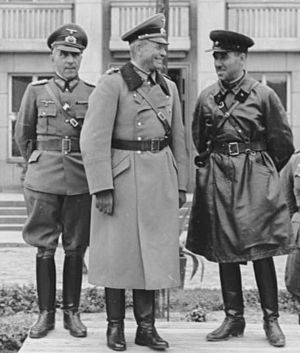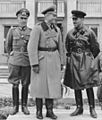Semyon Krivoshein facts for kids
Quick facts for kids
Semyon Moiseevich Krivoshein
|
|
|---|---|

Generalleutnant Mauritz von Wiktorin (left), General der Panzertruppe Heinz Guderian (center) and Kombrig Semyon Krivoshein (right) at the German-Soviet joint parade in Brest-Litovsk on September 22, 1939.
|
|
| Born | November 28, 1899 Voronezh, Russian Empire |
| Died | September 16, 1978 (aged 78) Moscow, Soviet Union |
| Allegiance | |
| Service/ |
Red Army |
| Years of service | 1918 — 1953 |
| Rank | Lieutenant General |
| Battles/wars | Russian Civil War Spanish Civil War Soviet-Japanese border conflicts World War II |
| Awards |
|
Semyon Moiseevich Krivoshein (Russian: Семён Моисе́евич Кривоше́ин; November 28, 1899 – September 16, 1978) was an important Soviet tank commander. He played a key role in making the Red Army's tank forces stronger during World War II. He was also a major figure in the huge tank battle at Prokhorovka, which was part of the Battle of Kursk.
Contents
Early Life and Joining the Army
Semyon Krivoshein was born in Voronezh, Russia, in 1899. He finished high school in 1917. In 1918, he joined the Red Army to fight in the Russian Civil War. He served with the 1st Cavalry Army.
Becoming a Tank Commander
After the Civil War ended in 1921, Krivoshein stayed in the army. When the Red Army started using tanks, he was chosen to learn about this new weapon. He studied at the important Frunze Military Academy and graduated in 1931. He then worked with mechanized troops, which included tanks. By 1934, he was in charge of a mechanized regiment.
Fighting in Spain
In 1936, Krivoshein volunteered to fight in Spain. He supported the Republicans against General Francisco Franco. Franco's side was helped by Fascist Italy and Nazi Germany. Krivoshein was the first Soviet tank commander in Spain. He arrived in October 1936 with a small group of Soviet volunteers and T-26 light tanks.
In November and December 1936, he led Republican tank forces in the Battle of Madrid. His brave actions helped boost the spirits of the Republicans. Even though his small tank force could not stop Franco's attack, he was praised for his leadership.
Battles in Asia
Krivoshein returned to the Soviet Union in January 1937. He was promoted and put in charge of a mechanized brigade. In 1938, he led his brigade against the Japanese in the Battle of Lake Khasan.
World War II Service
Starting the War: Poland and Finland
In August 1939, Germany and the Soviet Union signed an agreement. Soon after, both countries invaded Poland. The Soviet Union attacked Poland on September 17, 1939. Poland was already fighting a German invasion that began on September 1.
Krivoshein commanded the 29th Light Tank Brigade. The Polish army was mostly fighting Germany in the west. This meant there was less fighting for Soviet troops in the east. The Soviet forces quickly advanced.
Meeting German Troops
The German army had moved past the agreed border between Germany and the Soviet Union. This led to German and Soviet troops meeting unexpectedly near the Bug River. Krivoshein's forces reached Brest-Litovsk and found German troops already there.
German officers invited Krivoshein to their headquarters. He met with German General Heinz Guderian. They talked, and the German troops agreed to move back to their agreed border. They handed over Brest-Litovsk and its fortress to the Soviet forces.
Guderian suggested a joint parade of Soviet and German troops. Krivoshein said his troops were too tired for a full parade. But he agreed to provide a military band and some soldiers to march with the German troops as they left. He and Guderian also stood together to watch the ceremony. This event is sometimes called the German-Soviet military parade in Brest-Litovsk.
Fighting in Finland
Krivoshein's tank brigade then fought in the Winter War against Finland in 1939-1940. The Finnish army fought bravely, but Krivoshein performed well. He was quickly promoted. In less than two years, he rose to command tank forces for a key military district. In 1940, he became a major-general. By April 1941, Krivoshein was in charge of the 25th Mechanized Corps.
Training Tank Crews (1941-1943)
When Germany invaded the Soviet Union in June 1941, Krivoshein's corps was involved in some unsuccessful counterattacks. From 1941 to 1943, Krivoshein led the Department of Training for the Red Army's Tank Forces. He was responsible for training Soviet tank crews. This was a big job because new tanks were being introduced, and the army needed to find the best ways to use them in battle.
The Battle of Kursk
In 1943, the Red Army prepared for the very important Battle of Kursk. Krivoshein was given command of the 3rd Mechanized Corps. This corps was part of Mikhail Katukov's 1st Tank Army. Krivoshein and Katukov were known as excellent defense planners for tank forces.
Krivoshein's job was to fight in the first line of defense in the south of the Kursk salient. He faced the German Army Group South, led by Field Marshal Erich von Manstein. Krivoshein's forces were positioned near the town of Oboyan. Along with another tank corps, he faced the main German attack, led by General Hermann Hoth.
Facing German Tanks
Krivoshein's tanks were not as strong as the German ones. The Germans had powerful Tiger I tanks with 88mm guns that could shoot about two kilometers. The Soviet T-34 tank had a smaller 76.2mm gun with a shorter range.
On July 6, 1943, the Germans attacked Krivoshein with Tiger tanks and huge Ferdinand assault guns. After very tough fighting, German tanks broke through a small part of the Soviet defenses. But Krivoshein's tanks held their ground.
The next morning, July 7, Hoth sent most of his German tanks against Krivoshein. The Soviet commanders sent Krivoshein more troops. In a fierce battle, Krivoshein's forces held off the German attack. By the end of the day, German air reports said, "The Russians are not falling back. They stand there on line. Our tanks are stopped. They are burning."
Soviet Victory
On July 8, the Germans launched another massive attack. Krivoshein moved his corps to a new defense position. But the Germans still could not break through his lines. This failure was a big problem for the German tanks.
Because they couldn't defeat Krivoshein, on July 9, Hoth changed his attack. He moved his forces towards another Soviet corps, leaving his right side open. On July 12, the powerful 5th Guards Tank Army attacked Hoth's open side. This was a huge blow to the German tanks. The 1st Tank Army also started a counterattack. By the end of the day, Hoth's forces had suffered terrible losses and had to retreat. The Wehrmacht lost the biggest tank battle in history. This battle was a turning point for the Red Army in the war.
After Kursk
After the battle, Joseph Stalin gave the 1st Tank Army and two of its best corps the highest Soviet military honors. Krivoshein's 3rd Mechanized Corps became the 8th Guards Mechanized Corps. Krivoshein was promoted to Lieutenant General. He received the Order of Suvorov for his excellent leadership.
The 1st Tank Army had lost many tanks and soldiers. Krivoshein's corps lost almost 90% of its commanders. Even so, they were ordered to attack again. After some initial success, they were stopped and pulled back to rest and get new equipment. In December 1943, Krivoshein's corps helped drive the Germans out of Ukraine.
From Belarus to Berlin
Krivoshein was badly wounded in a battle and spent several months recovering. In 1944, he took command of the 1st Mechanized Krasnograd Corps. He fought in Operation Bagration, a huge Soviet attack that crushed the German Army Group Centre in Belarus. Krivoshein helped recapture many cities, including Brest.
In the final days of the war, in spring 1945, Krivoshein led his corps in the front lines of the 1st Belorussian Front. This front was led by Georgy Zhukov, one of the top Soviet commanders. Stalin gave Zhukov the honor of taking Berlin. Zhukov trusted Krivoshein to lead the Soviet armies in the final victory over Germany.
Krivoshein's forces broke through strong German defenses in the tough Battle of Seelow Heights. He then fought his way to the Reichstag building in Berlin. For his amazing leadership and bravery in capturing Berlin, Krivoshein received the highest Soviet war honor: Hero of the Soviet Union.
Life After the War
Krivoshein continued to command his corps until 1946. Then he became the Head of Department at the M. V. Frunze Military Academy. In 1950, he moved to Odessa to command mechanized and tank forces there. In 1951, he was chosen for higher command and studied at the Higher Military Academy of the General Staff. He graduated in 1952.
After Stalin's death in March 1953, the Soviet army began to shrink. On May 4, 1953, Krivoshein retired after 35 years of service. He spent the last 25 years of his life writing four books about his war experiences.
Awards and Honors
- Hero of the Soviet Union (1945)
- Three Orders of Lenin
- Three Orders of the Red Banner
- Order of Suvorov, 2nd Class
- Order of Kutuzov, 1st Class
- Order of the Red Star
- "Honorary Citizen of Brest"
- Many jubilee medals for military service and victory in World War II.
Images for kids
See also
 In Spanish: Semión Krivoshéin para niños
In Spanish: Semión Krivoshéin para niños


